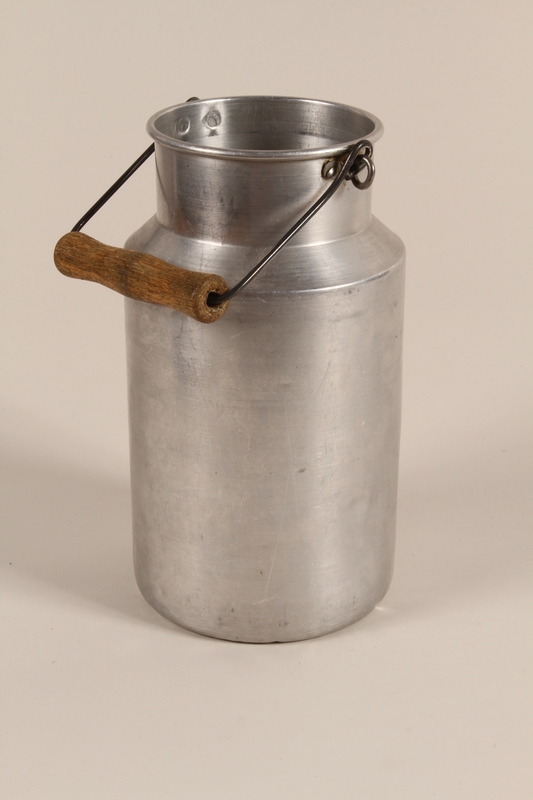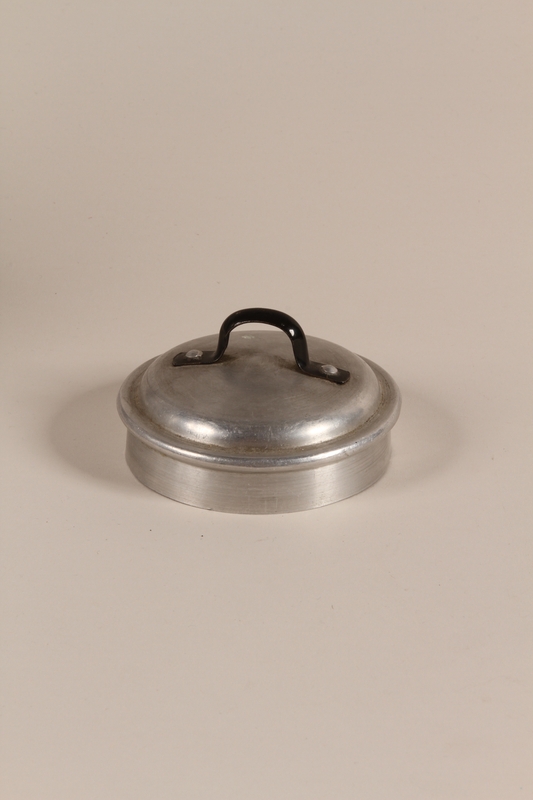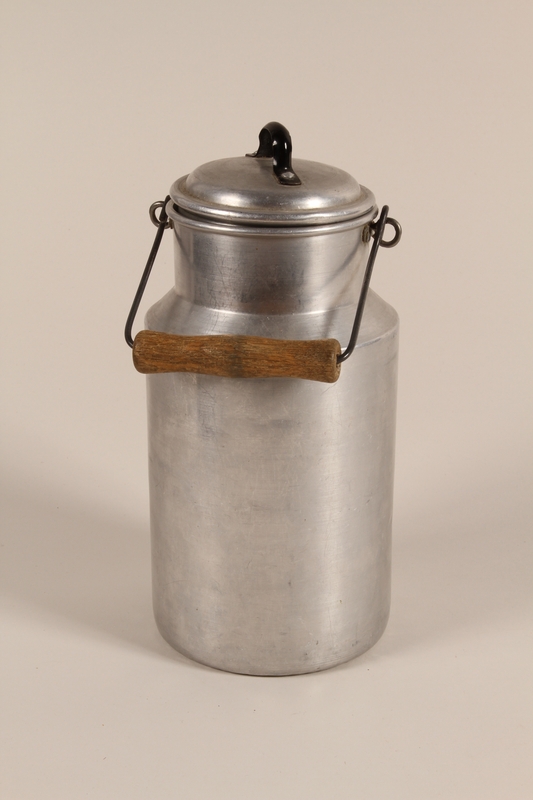Overview
- Brief Narrative
- Milk can used by Theresia Winterstein Reinhardt and her family when they lived in a Sinti camp in Germany after World War II. The family had traveled widely until the Nazi regime restricted Sinti migrations in the 1930s. Theresia met Gabriel Reinhardt in 1941 when they both worked at the Stadttheater in Wurzburg. Persecution of the Sinti was escalating. They were no longer allowed to work at the theater. Several members of Theresia's family were forced to agree to sterilization. Theresia and Gabriel decided to have a child, and when Theresia was called in for sterilization she was 3 months pregnant with twins. The Germans permitted the pregnancy to continue and Rita and Rolanda were born in 1943. The infants were taken from their parents by Nazi eugenicists and used in medical experiments. Only Rita survived and was returned to her parents in 1944 by the German Red Cross.
- Date
-
use:
1945-1955
- Geography
-
use:
Wurzburg (Germany)
- Credit Line
- United States Holocaust Memorial Museum Collection, Gift of Rita Prigmore
- Markings
- a. side, below rim, stamped : REIN ALUMINIUM / 21
- Contributor
-
Subject:
Rita Prigmore
Subject: Theresia Seible
- Biography
-
Rita Reinhardt was born into a Sinti family on March 3, 1943, in Wurzburg, Germany. She had a twin sister, Rolanda. Their father, Gabriel, was born January 7, 1913, in Marbach into a family with a long musical heritage. He studied at a music conservatory in Stuttgart and played violin in a band with his 4 brothers, until the band disbanded in the late 1930s under restrictions established by the Nazi regime. The twins’ mother was Theresia Winterstein, born December 21,1921, in Manheim. Her parents met in 1941 when they were both performing at the Wurzburg Stadttheater. In 1941, several members of her mother’s family were brought to Gestapo headquarters where they were forced to sign sterilization authorization forms. They were threatened with deportation if they refused. Both Theresia and Gabriel were no longer permitted to perform at the Stadttheater. Before Theresia's sterilization was scheduled, she made a decision with Gabriel to get pregnant. By the time she was called in for the procedure in 1942, she was three months pregnant with twins. When this was discovered by the racial hygienists, she and her family were detained and an inquiry was sent to Berlin to determine what should be done. The response was that Theresia should be allowed to continue the pregnancy on condition that the babies be turned over to the clinic at the University of Wurzburg as soon as they were born. There, Dr. Werner Heyde, professor of neurology and psychiatry, and a key member of the Nazi euthanasia program, was conducting research on twins. Throughout her pregnancy, Theresia and Gabriel were under constant surveillance. The twins were born in the presence of Dr. Heyde at the University of Wurzburg. In the first few weeks after they were born, they were allowed brief stays at home with their parents, but otherwise were confined to the clinic. On one occasion, the twins were released to their parents for a propaganda photo shoot of Sinti parents strolling with their babies along the Domstrasse in Wurzburg.
In the second week of April 1943, Theresia and Gabriel received notice to report for deportation. Their daughters were not included in the notice, and Theresia and her parents went to the clinic to see them. When they arrived they were told they could not see the infants, but Theresia pushed her way in. She found only Rita, who had a bandaged head. She grabbed the baby and Theresia’s father smuggled her out of the building. Theresia was told by one of the nurses that Rolanda had died during experimental surgery that day, April 11. Rita had a one inch incision on the side of her head. The family fled, but within a day or two, the Gestapo caught them and took Rita back to the clinic. Her parents were no longer allowed to see her. Rolanda's body was released to her parents and they arranged for a proper Sinti funeral. Her head had incisions similar to Rita’s, apparently from an experiment to dye her eyes from brown to blue. Close to this time, Theresia was forcibly sterilized. Gabriel lost his job with the pharmaceutical company, but was not subjected to sterilization. They were not deported, though a number of other relatives were deported to Dachau and Auschwitz. On March 23, 1944, Theresia and Gabriel married. In April, Theresia received a letter from the German Red Cross instructing her to come and pick up Rita. The family remained together until 1947 when Gabriel's first wife, who had been resumed dead, returned to Germany. Gabriel decided to go back to her and had his second marriage to Theresia annulled. Rita remained with her mother. Throughout her youth and adulthood, she suffered headaches, blackouts, and other health problems attributed to the experiments at the Wurzburg clinic. Rita remained with her mother and her family and did not meet her father again until 1959. Rita married at 21 and soon after gave birth to a son and daughter. She and her family moved to the United States in the 1970s. After several years, Rita divorced her husband (and ultimately left her children, as well) in order to move back to Germany to help her mother run a Sinti human rights organization that sought to raise consciousness about the fate of the Roma during the Holocaust. Her mother died in 2007. Rita continues to work for the organization.
Theresia Winterstein was born into a Sinti family on December 21,1921, in Mannheim, Germany. Her parents were Johann, born February 20, 1898, in Gundelfingen, and Josephine Spindler, born December 28, 1896, in Zimmern. Johann was a basket weaver by trade. The family traveled widely in Western and Central Europe, until the Nazi regime restricted Roma migrations. Her mother was arrested in the 1930s for the crime of spreading lies about the Nazi regime, but she was released since she only did this through verbal means. Theresia attended a convent school and then trained as a singer and dancer. In 1941, she was performing regularly at the Stadttheater in Wurzburg. She met Gabriel Reinhardt who played violin in the orchestra. Gabriel was a full-blood Sinti, born on January 7, 1913, in Marbach into a family with a long musical heritage. He studied at a music conservatory in Stuttgart and played violin in a band with his four brothers, until the band disbanded in the late 1930s under restrictions imposed by the Nazi regime. He had previously been married, with a son, Rigo, born in 1938, but his wife had been deported in 1939 by Nazi authorities. Gabriel was later informed that she died in Auschwitz.
In 1941, several members of Theresia's family were brought to Gestapo headquarters where they were forced to sign sterilization authorization forms. They were threatened with deportation if they refused. Both Theresia and Gabriel were no longer permitted to perform at the Stadttheater. Theresia took a job as an usher and Gabriel went to work as a bicycle delivery man for a pharmaceutical company. Before Theresia's sterilization was scheduled, she made a decision with Gabriel to get pregnant. By the time she was called in for the procedure in 1942, she was three months pregnant with twins. When this was discovered by the racial hygienists, she and her family were detained and an inquiry was sent to Berlin to determine what should be done. The response was that Theresia should be allowed to continue the pregnancy on condition that the babies be turned over to the clinic at the University of Wurzburg as soon as they were born. There, Dr. Werner Heyde, professor of neurology and psychiatry, and a key member of the Nazi euthanasia program, was conducting research on twins. Throughout her pregnancy, Theresia and Gabriel were under constant surveillance. Twin girls, Rita and Rolanda, were born on March 3, 1943, in the presence of Dr. Heyde at the University of Wurzburg. In the first few weeks after they were born, they were allowed brief stays at home with their parents, but otherwise were confined to the clinic. On one occasion, the twins were released to their parents for a propaganda photo shoot of Sinti parents strolling with their babies along the Domstrasse in Wurzburg.
In the second week of April 1943, Theresia and Gabriel received notice to report for deportation. Their daughters were not included in the notice, and Theresia and her parents went to the clinic to see them. When they arrived they were told they could not see the infants, but Theresia pushed her way in. She found only Rita, who had a bandaged head. She grabbed the baby and Theresia’s father smuggled her out of the building. Theresia then learned that Rolanda had died during experimental surgery that day, April 11. Rita had a one inch incision on the side of her head. The family fled, but within a day or two, the Gestapo caught them and took Rita back to the clinic. Her parents were no longer allowed to see her. Rolanda's body was released to her parents and they arranged for a proper Sinti funeral. Her head had incisions similar to Rita’s, apparently from an experiment to dye her eyes from brown to blue. Close to this time, Theresia was forcibly sterilized. Her father was as well. Gabriel lost his job with the pharmaceutical company, but was not subjected to sterilization. They were not deported, though several members of Theresia's extended family, including her younger brother, Otto Winterstein, and her uncle, Fritz Spindler, were deported; both survived. On March 23, 1944, Theresia and Gabriel married. In April, Theresia received a letter from the German Red Cross instructing her to come and pick up Rita. The family remained together until 1947 when Gabriel's first wife, who had survived the war after all, returned to Germany. Gabriel decided to go back to her and had his second marriage to Theresia annulled. Rita remained with her mother. In 1962, Theresia was remarried to an American soldier named Seible, who died in 1972. Rita suffered numerous physical ailments, including severe headaches and periodic loss of consciousness, throughout her youth and adulthood that she and her mother attribute to her treatment at the Wurzburg clinic during the Nazi period. Rita married in 1964 and had two children. They eventually immigrated to the United States. Theresia helped establish and run a Sinti human rights organization in Germany that seeks to raise consciousness about the fate of Roma during the Holocaust. Rita returned to Wurzburg in the 1970s to assist her. Theresia passed away April 1, 2007, age 86.
Physical Details
- Language
- German
- Classification
-
Containers
- Category
-
Metal containers
- Object Type
-
Milk cans (lcsh)
- Physical Description
- a. Cylindrical aluminum can that narrows 2 thirds of the way up and has a curled rim around the opening. There is a stamped number near the top with text in a semi-circle. A wire handle with a cylindrical wooden grip is attached by 2 rings riveted near the top.
b. Aluminum can lid with a raised, rounded top, a ridge around the edge, and vertical sides that fit into the can opening. A metal handle painted black is attached on top by rivets. - Dimensions
- a: Height: 8.750 inches (22.225 cm) | Diameter: 4.620 inches (11.735 cm)
b: Height: 1.880 inches (4.775 cm) | Diameter: 3.620 inches (9.195 cm) - Materials
- a : metal, wood
b : metal, paint
Rights & Restrictions
- Conditions on Access
- No restrictions on access
- Conditions on Use
- No restrictions on use
Keywords & Subjects
Administrative Notes
- Legal Status
- Permanent Collection
- Provenance
- The milk can was donated to the United States Holocaust Memorial Museum in 2005 by Rita Prigmore, the daughter of Gabriel Reinhardt and Theresia Winterstein Seible.
- Record last modified:
- 2022-09-28 15:49:59
- This page:
- https://collections.ushmm.org/search/catalog/irn517651
Download & Licensing
In-Person Research
- By Appointment
- Request 21 Days in Advance of Visit
- Plan a Research Visit
- Request to See This Object
Contact Us
Also in Gabriel Reinhardt and Theresia Winterstein families collection
The collection consists of a decorative box, lantern, milk can, tarp, two violins with bows, violin case, a small wooden wagon, wicker basket, and a small rug relating to the experiences of the Sinti families of Gabriel Reinhardt and Theresia Winterstein and thier daughters, Rita and Rolanda. in Germany before, during, and after the Holocaust.
Date: 1930-1950
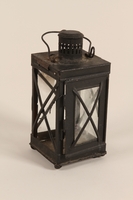
Lantern and candle used by a Sinti family
Object
Lantern used by Theresia Winterstein Reinhardt and her family when they lived in a Sinti camp in Germany after World War II. It could be hung on their wagon or carried by hand. The family had traveled widely until the Nazi regime restricted Sinti migrations in the 1930s. Theresia met Gabriel Reinhardt in 1941 when they both worked at the Stadttheater in Wurzburg. Persecution of the Sinti was escalating. They were no longer allowed to work at the theater. Several members of Theresia's family were forced to agree to sterilization. Theresia and Gabriel decided to have a child, and when Theresia was called in for sterilization she was 3 months pregnant with twins. The Germans permitted the pregnancy to continue and Rita and Rolanda were born in 1943. The infants were taken from their parents by Nazi eugenicists and used in medical experiments. Only Rita survived and was returned to her parents in 1944 by the German Red Cross.
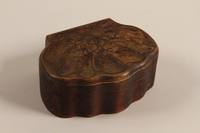
Wooden keepsake box from a Sinti family
Object
Small wooden jewelry box kept by Rita Prigmore and originally owned by her grandmother, Josefine Winterstein. The family was Sinti. They had traveled widely in Western and Central Europe until the Nazi regime restricted Sinti migrations in the 1930s. Rita's parents, Theresia Winterstein and Gabriel Reinhardt, met in 1941 when they both worked at the Stadttheater in Wurzburg, Germany. Persecution of the Roma was escalating. They were no longer allowed to work at the theater. Several members of Theresia's family were forced to agree to sterilization. Theresia and Gabriel decided to have a child, and Rita and her twin sister, Rolanda, were born in 1943. The infants were taken from their parents by Nazi eugenicists and used in medical experiments. Only Rita survived and was returned to her parents in 1944 by the German Red Cross.

Small, hand drawn wooden wagon used by a Sinti family
Object
Small wagon used by Rita Prigmore when she was a child in Wurzburg, Germany, and after World War II, to cart bricks from the rubble of bombed buildings to help build a new home for the family. The Winterstein family were Sinti. They had traveled widely in Western and Central Europe until the Nazi regime restricted Sinti migrations in the 1930s. Rita's parents, Theresia Winterstein and Gabriel Reinhardt, met in 1941 when they both worked at the Stadttheater in Wurzburg. Persecution of the Sinti was escalating. They were no longer allowed to work at the theater. Several members of Theresia's family were forced to agree to sterilization. Theresia and Gabriel decided to have a child, and Rita and her twin sister, Rolanda, were born in 1943. The infants were taken from their parents by Nazi eugenicists and used in medical experiments. Only Rita survived and was returned to her parents in 1944 by the German Red Cross.

Small hooked rug used in the wagon of a Sinti family
Object
Small patterned hooked rug used as a shoe mat in the wagon of Rita Prigmore and her family when she was a child in Wurzberg, Germany, after World War II. The Winterstein family had traveled widely in Western and Central Europe until the Nazi regime restricted Sinti migrations in the 1930s. Rita's parents, Theresia Winterstein and Gabriel Reinhardt, met in 1941 when they both worked at the Stadttheater in Wurzburg. Persecution of the Sinti was escalating. They were no longer allowed to work at the theater. Several members of Theresia's family were forced to agree to sterilization. Theresia and Gabriel decided to have a child, and Rita and her twin sister, Rolanda, were born in 1943. The infants were taken from their parents by Nazi eugenicists and used in medical experiments. Only Rita survived and was returned to her parents in 1944 by the German Red Cross.
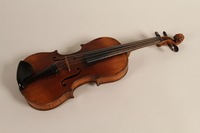
Violin used by a Sinti musician
Object
Violin owned by Rita Prigmore and originally used by her father, Gabriel Reinhardt, who played with his four brothers in a Roma band in Germany before World War II. The Nazi regime restricted Roma migrations in the 1930s. Gabriel met Theresia Winterstein in 1941 when they both worked at the Stadttheater in Wurzburg, Germany. Persecution of the Roma was escalating and several members of both families were forced to agree to sterilization. Gabriel and Theresia decided to have a child, and when Theresia was called in for sterilization she was 3 months pregnant with twins. The Germans permitted the pregnancy to continue and Rita and Rolanda were born in 1943. The infants were taken from their parents by Nazi eugenicists and used in medical experiments. Only Rita survived and was returned to her parents in 1944 by the German Red Cross.
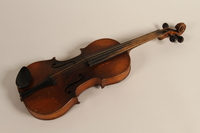
Violin used by a Sinti musician
Object
Violin owned by Rita Prigmore and originally used by her father, Gabriel Reinhardt, who played with his four brothers in a Sinti band in Germany before World War II. The Nazi regime restricted Sinti migrations in the 1930s. Gabriel met Theresia Winterstein in 1941 when they both worked at the Stadttheater in Wurzburg, Germany. Persecution of the Sinti was escalating. They were no longer allowed to work at the theater. Several members of both families were forced to agree to sterilization. Gabriel and Theresia decided to have a child, and when Theresia was called in for sterilization she was 3 months pregnant with twins. The Germans permitted the pregnancy to continue and Rita and Rolanda were born in 1943. The infants were taken from their parents by Nazi eugenicists and used in medical experiments. Only Rita survived and was returned to her parents in 1944 by the German Red Cross.
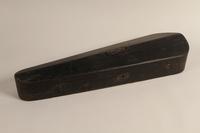
Violin case used by a Sinti musician
Object
Wooden coffin style violin case owned by Rita Prigmore and originally used by her father, Gabriel Reinhardt, who played with his four brothers in a Sinti band in Germany before World War II. The Nazi regime restricted Sinti migrations in the 1930s. Gabriel met Theresia Winterstein in 1941 when they both worked at the Stadttheater in Wurzburg, Germany. Persecution of the Sinti was escalating. They were no longer allowed to work at the theater. Several members of both families were forced to agree to sterilization. Gabriel and Theresia decided to have a child, and when Theresia was called in for sterilization she was 3 months pregnant with twins. The Germans permitted the pregnancy to continue and Rita and Rolanda were born in 1943. The infants were taken from their parents by Nazi eugenicists and used in medical experiments. Only Rita survived and was returned to her parents in 1944 by the German Red Cross.

Violin bow used by a Sinti musician
Object
Violin bow owned by Rita Prigmore and originally used by her father, Gabriel Reinhardt, who played with his four brothers in a Sinti band in Germany before World War II. The Nazi regime restricted Sinti migrations in the 1930s. Gabriel met Theresia Winterstein in 1941 when they both worked at the Stadttheater in Wurzburg, Germany. Persecution of the Sinti was escalating. They were no longer allowed to work at the theater. Several members of both families were forced to agree to sterilization. Gabriel and Theresia decided to have a child, and when Theresia was called in for sterilization she was 3 months pregnant with twins. The Germans permitted the pregnancy to continue and Rita and Rolanda were born in 1943. The infants were taken from their parents by Nazi eugenicists and used in medical experiments. Only Rita survived and was returned to her parents in 1944 by the German Red Cross.
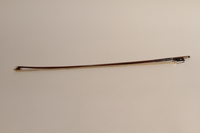
Violin bow used by a Sinti musician
Object
Violin bow owned by Rita Prigmore and originally used by her father, Gabriel Reinhardt, who played with his four brothers in a Sinti band in Germany before World War II. The Nazi regime restricted Sinti migrations in the 1930s. Gabriel met Theresia Winterstein in 1941 when they both worked at the Stadttheater in Wurzburg, Germany. Persecution of the Sinti was escalating. They were no longer allowed to work at the theater. Several members of both families were forced to agree to sterilization. Gabriel and Theresia decided to have a child, and when Theresia was called in for sterilization she was 3 months pregnant with twins. The Germans permitted the pregnancy to continue and Rita and Rolanda were born in 1943. The infants were taken from their parents by Nazi eugenicists and used in medical experiments. Only Rita survived and was returned to her parents in 1944 by the German Red Cross.
Handmade woven wicker basket made by a Sinti family
Object
Wicker basket owned by Rita Prigmore and made by her grandfather, Johann Winterstein, a basket weaver by trade. The family were Sinti. They had traveled widely in Western and Central Europe until the Nazi regime restricted Sinti migration in the 1930s. Rita's parents, Theresia Winterstein and Gabriel Reinhardt, met in 1941 when they both worked at the Stadttheater in Wurzburg. Persecution of the Sinti was escalating. They were no longer allowed to work at the theater. Several members of Theresia's family were forced to agree to sterilization. Theresia and Gabriel decided to have a child, and Rita and her twin sister, Rolanda, were born in 1943. The infants were taken from their parents by Nazi eugenicists and used in medical experiments. Only Rita survived and was returned to her parents in 1944 by the German Red Cross.
Tarp used to make a tent around a Sinti wagon
Object
A section of a tarp kept by Rita Prigmore and originally used as a skirt around her family's wagon when she was a child in Wurzburg, Germany, after World War II. The tarp made a shelter under the wagon for the children. The Winterstein family were Sinti. They had traveled widely in Western and Central Europe until the Nazi regime restricted Sinti migrations in the 1930s. Rita's parents, Theresia Winterstein and Gabriel Reinhardt, met in 1941 when they both worked at the Stadttheater in Wurzburg. Persecution of the Sinti was escalating. They were no longer allowed to work at the theater. Several members of Theresia's family were forced to agree to sterilization. Theresia and Gabriel decided to have a child, and Rita and her twin sister, Rolanda, were born in 1943. The infants were taken from their parents by Nazi eugenicists and used in medical experiments. Only Rita survived and was returned to her parents in 1944 by the German Red Cross.

